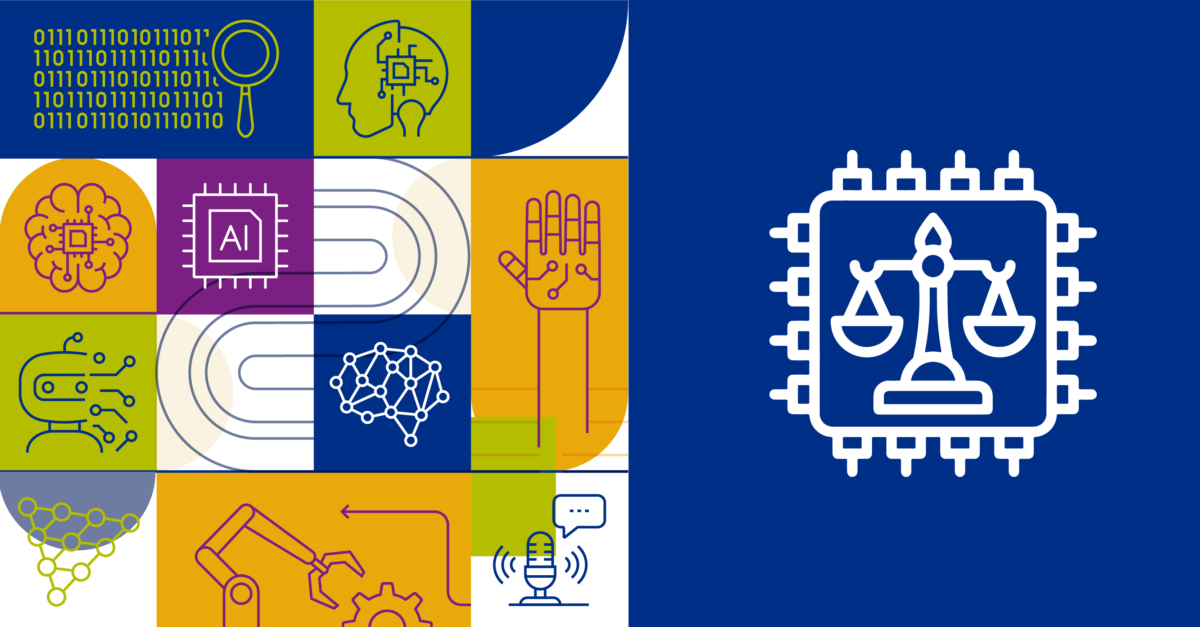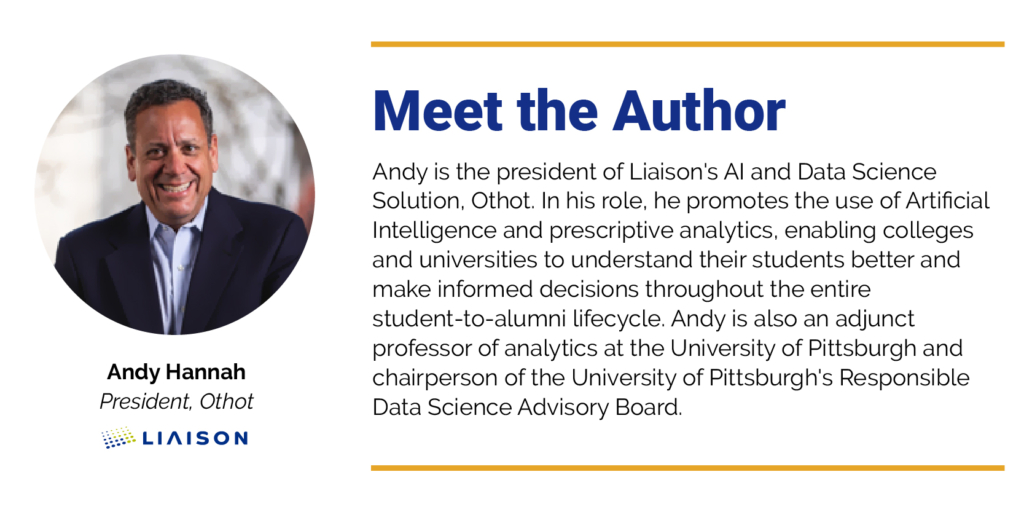As we step into 2024, the pervasive influence of AI is increasingly evident in nearly every aspect of our daily lives. In this evolving landscape, AI in higher education is reshaping how institutions approach learning, making transformative impacts across the field. While many people may see the rise of AI tools like ChatGPT and think higher education is heading into unexplored waters, AI for higher education is not a new idea, and ChatGPT is just one tool in the AI arsenal. The impact of AI in education goes beyond course design and delivery. AI technologies play a vital role throughout the entire collegiate cycle, from attracting and enrolling new students to supporting their journey toward graduation.
While Liaison is at the forefront of aiding education leaders in understanding the impact of AI on campus and harnessing student data for improved recruitment and retention, the expanding role of AI in higher education also brings forth growing concerns about its ethical implications. To maximize the benefits of AI in identifying ideal student candidates and facilitating their success, higher education institutions must confront these ethical challenges head-on.
What are the Benefits of AI in Higher Education?
The heart of AI lies in enhancing student experiences through ethical and purposeful use, with ethical considerations for AI playing a crucial role in guiding its application. It begins with an institution’s core mission, shaping its actions and decisions. Aligning AI with this mission across students, faculty, and administration ensures that values are reflected and contribute to an institution’s overall educational goals. AI’s role is to augment, not replace, the expertise of higher education professionals, enhancing their abilities to serve students and campuses effectively.
Efficient messaging strategy. AI in higher education can play a pivotal role in identifying and attracting students that best match the institution’s mission, ensuring a more compelling message tailored to their needs. By using AI to effectively target and engage prospective students, institutions can create content that stands out from traditional marketing materials and speaks directly to each student.
Reliable operation support. AI can be viewed as a committed, hard-working partner to higher education staff. Universities are full of dedicated staff serving students, but they need help, and AI supports university staff by analyzing data, simplifying processes, and providing information that is needed to make important decisions.
Less-biased perspectives. AI in higher education could act as a less biased “pair of eyes.” We all have biases, which are often reflected in the data underlying the AI, but when used correctly, ethical considerations for AI can ensure it provides a mechanism to detect and defend against biased perspectives on student applicants. This impartial approach can enhance holistic admissions admissions by standardizing and evaluating personal qualities and attributes across numerous applications, effectively merging the strengths of both human and machine analysis.
How does AI in Higher Education Shape Enrollment Strategies?
The adoption of data and insights-driven decision-making is revolutionizing how universities enroll students.
AI helps schools prioritize data. The significance of data and the growing acknowledgment of its power in shaping the future of higher education is pushing institutions to deepen their understanding of how to use it effectively. Ethical considerations for AI are essential in this process, ensuring data is handled responsibly and transparently. Teams recognize the need to collect data for analysis and decision-making; they understand that they risk falling behind the competition without insights from marketing campaigns or events.
While many universities are still in the early or intermediate stages of using data, a smaller group is embracing more advanced stages, leveraging data predictively and prescriptively to shape future outcomes. This move away from guesswork and toward data-driven campaigns is revolutionizing the enrollment process.
AI in higher education takes the guesswork out of campaigns. Liaison’s Othot solution is leading the way in applying advanced analytics to the enrollment process, creating a platform capable of both prediction and prescription. Unlike other organizations’ solutions, which typically rely on linear modeling, Othot’s nonlinear system comprehends individual behaviors and integrates probabilities into campaigns.
Othot’s strength is in understanding each individual’s behavior—those that influence decisions in enrollment management in higher education and a student’s on-campus success—and helps guide specific actions to improve outcomes. This allows universities to target and engage specific audiences effectively. For example, Liaison successfully collaborated with a renowned university in the Southwest to attract more students from adjacent states, using predictive analytics to tailor its marketing strategies.
AI enables more personalized campaigns. The strength of AI in higher education lies in its ability to understand the unique characteristics of each individual. This personalization is crucial in the recruitment process, where universities face multiple complexities. Take, for example, a university trying to determine student interest in the geographic location of a college. Traditional linear models might struggle to differentiate between students who prefer staying close to home and those who desire to study far away. However, Liaison’s Othot AI solution adopts a more personalized approach to data analysis, enabling them to identify these distinct preferences accurately.
What are the Practical and Ethical Considerations for AI in Higher Education?
For colleges and universities grappling with a range of challenges, the prospect of harnessing data more effectively can appear daunting. Many are uncertain about where or how to initiate this journey. Even for those already utilizing some data, the idea of expanding existing data strategies may be met with uncertainty.
Making the transition into using data more effectively. Numerous schools are still progressing in their journey to collect and utilize data efficiently. They are focused on establishing more straightforward and user-friendly systems to compile key data from various sources, such as student records and course evaluations. AI in higher education aims to amalgamate all this data into a unified, coherent format. This consolidation would simplify the process of identifying overarching trends and insights, enhancing decision-making for the benefit of the school and its students. This method represents a novel direction for many educational institutions, and they are steadily improving in this area.
Empowering staff to mine data for actionable insights. As universities shift toward a data-centric approach, they often grapple with the challenge of their teams adapting to data-related roles. Most university staff are not experts in mathematics, yet they need to acquire core skills to use data to understand student behaviors more effectively. The Chronicle of Higher Education’s recent survey highlights this dilemma: 62% of college leaders report difficulties in hiring staff, but 97% aspire to head data-driven institutions. This disparity underscores the necessity for collaboration and training programs to bridge the gap, enabling nonscientific professionals to develop the requisite data-related skills.
Recognizing bias for equity and fairness. A common misunderstanding is the necessity of employing AI in higher education to detect bias as a preliminary step toward addressing it. For instance, a business school might find its enrollment is comprised of 60% men and 40% women. Understanding the origins of this disparity, its underlying causes, and how AI can help rectify it requires a multifaceted approach. Ethical considerations for AI are essential in this process, as algorithms inherently may exhibit biases, as they are shaped by human thought processes and reactions during development as well as historical data. Consequently, universities must work within the context of AI, understanding any limitations, to identify and mitigate these biases when formulating strategies to promote equity and fairness.
AI in higher education establishes ethical and responsible AI guidelines for diverse campuses. The goal of higher education is to foster a diverse and enriching learning environment. This involves creating a community of individuals from varied races, ethnicities, socioeconomic and religious backgrounds, and educational experiences that reflect the diversity of the broader community. To achieve this, it’s crucial to guarantee fairness in admissions and to counterbalance negative biases actively with positive initiatives that support underrepresented groups. The Supreme Court’s decision prohibiting the use of race in admission decisions adds a layer of complexity for institutions striving to cultivate a diverse student body and rectify biases in recruitment processes. It can be a relief for universities to understand that they can use AI ethically and constructively to overcome these challenges.
What Are the Principles of Responsible AI in Higher Education?
Educational institutions must consider a multifaceted approach to ensure their AI practices align with responsible and ethical standards. While the AI conversation often gravitates toward ethics and fairness, ethical considerations for AI are crucial to maintaining integrity and transparency in these practices. It is important to have a broader perspective, As responsible data science involves taking a thoughtful and comprehensive view of how AI integrates into decision-making processes.
In the development of algorithms for AI in Higher Education for institutional use, the primary goal should be to facilitate better decision-making. This demands a sense of responsibility, which encompasses several key elements:
Transparency
Educational institutions should prioritize transparency in their AI practices. This means being open about how AI systems are utilized, the data they rely on, and the decision-making processes involved. Transparency helps build trust among stakeholders.
Trust
Establishing trust in AI systems is paramount. Institutions must ensure that their AI-driven decisions are reliable. Regular testing, validation, and quality control processes contribute to building trust in the technology.
Ethics
Ethics is a central aspect of responsible AI in higher education and should not be viewed in isolation. Ethical considerations encompass a range of issues, including data privacy, consent, and the potential impact of AI on individuals and communities. Institutions must uphold ethical principles throughout their AI practices.
Bias Mitigation
Addressing the issue of bias in the design of AI algorithms and when interpreting data is crucial. Ethical considerations for AI play a key role here as institutions should actively work to identify and mitigate biases that may emerge, particularly those that could negatively affect underrepresented or disadvantaged groups.
Conclusion
The ethical framework guiding AI in higher education extends beyond mere algorithms and data points; it represents a commitment to fairness, inclusivity, and the fulfillment of educational missions. With transparency serving as a beacon, institutions can navigate the evolving landscape of AI with integrity, ensuring that every student’s journey is marked by genuine support, equal access, and a promise of trustworthiness in their educational experience. In this pursuit, higher education institutions become not only guardians of knowledge but also champions of ethical AI, paving the way for a brighter, more equitable future for all.

